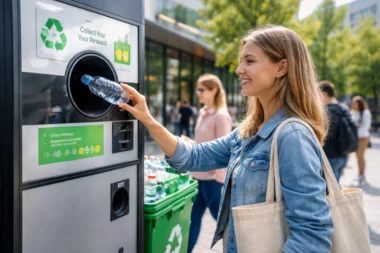Introduction:
In pursuing a more sustainable and environmentally friendly construction industry, recycled plastic materials have gained significant attention. Recycled plastics offer a compelling solution to reduce waste, conserve resources, and minimize the carbon footprint of construction projects. In this article, we will explore the introduction of recycled plastic materials for construction applications, their uses, and the techniques and step-by-step process involved in producing these materials.
Recycled Materials in Construction:
Recycled plastic materials find diverse applications in the construction industry, contributing to sustainable infrastructure development. These materials are used in various forms, including:
1. Recycled Plastic Lumber: Recycled plastic lumber, also known as plastic wood or timber, is a durable and versatile alternative to traditional wood. It is commonly used for decking, fencing, landscaping, and outdoor furniture. Recycled plastic lumber reduces the demand for virgin timber and offers enhanced rot, insects, and moisture resistance.
2. Recycled Plastic Roofing Tiles: Roofing tiles from recycled plastic offer excellent durability and weather resistance. These tiles are lightweight, easy to install, and provide a sustainable alternative to traditional roofing materials. They contribute to reducing the consumption of natural resources and generating waste from roofing projects.
3. Recycled Plastic Pavers: Recycled plastic pavers are used for constructing driveways, walkways, and parking lots. These pavers are made of recycled plastic and offer high strength, durability, and permeability. They contribute to stormwater management by allowing water infiltration, reducing runoff, and promoting groundwater recharge.
Step-by-Step Process of Making Recycled Plastic Material for Construction:
1. Collection and Sorting: The first step in producing recycled plastic materials for construction involves collecting plastic waste from various sources, such as post-consumer products, industrial waste, and packaging materials. The collected plastic is then sorted based on its type and quality.
2. Cleaning and Pre-treatment: The sorted plastic waste undergoes cleaning to remove impurities such as dirt, labels, and contaminants. The cleaning process may involve washing, shredding, or melting the plastic to ensure it is free from unwanted substances.
3. Melting and Extrusion: The cleaned and pre-treated plastic is melted using heat to transform it into a molten state. The molten plastic is then extruded through a die, which gives it the desired shape and form. For instance, molten plastic is extruded into boards or planks for recycled plastic lumber.
4. Cooling and Solidification: After extrusion, the plastic material is cooled rapidly to solidify it into the desired shape. Cooling methods such as water baths or air cooling are employed to achieve proper solidification and maintain the material’s structural integrity.
5. Finishing and Quality Control: The recycled plastic material is further processed to meet specific requirements. This may involve cutting, sanding, or treating the material to enhance its surface finish and ensure it meets quality standards. Quality control measures are implemented to assess the recycled plastic material’s strength, durability, and other properties.
6. Application in Construction: The finished recycled plastic material is ready for construction applications. It can be used as a direct substitute for traditional construction materials or in combination with other materials to achieve the desired structural requirements. Recycled plastic material contributes to sustainable construction practices by reducing the consumption of virgin resources and diverting plastic waste from landfills.
Conclusion:
Adopting recycled plastic materials in construction holds great promise for a more sustainable and environmentally conscious industry. The construction sector can contribute to reducing waste generation and conserving natural resources by using recycled plastic lumber, roofing tiles, pavers, and other applications. The step-by-step process of collecting, sorting, cleaning, melting, and shaping recycled plastic materials demonstrates the construction industry’s commitment to building a greener future. By embracing these sustainable alternatives, we can move towards a more circular economy and create a more resilient and sustainable built environment.



